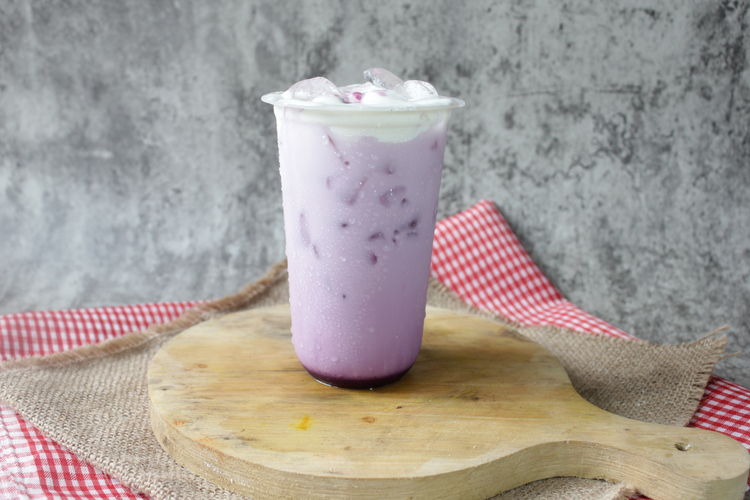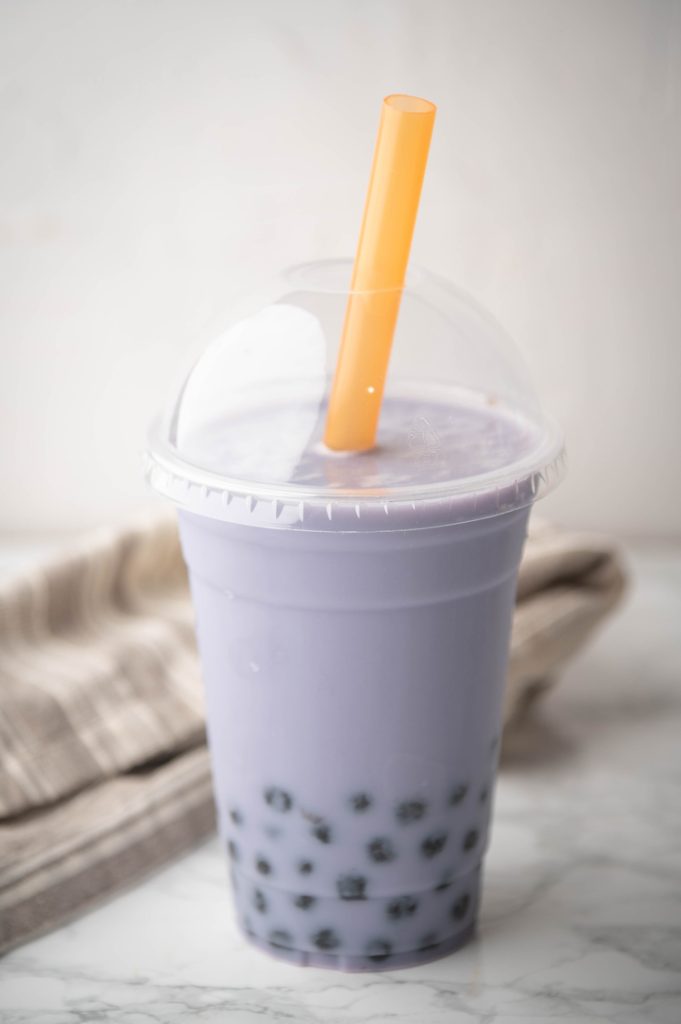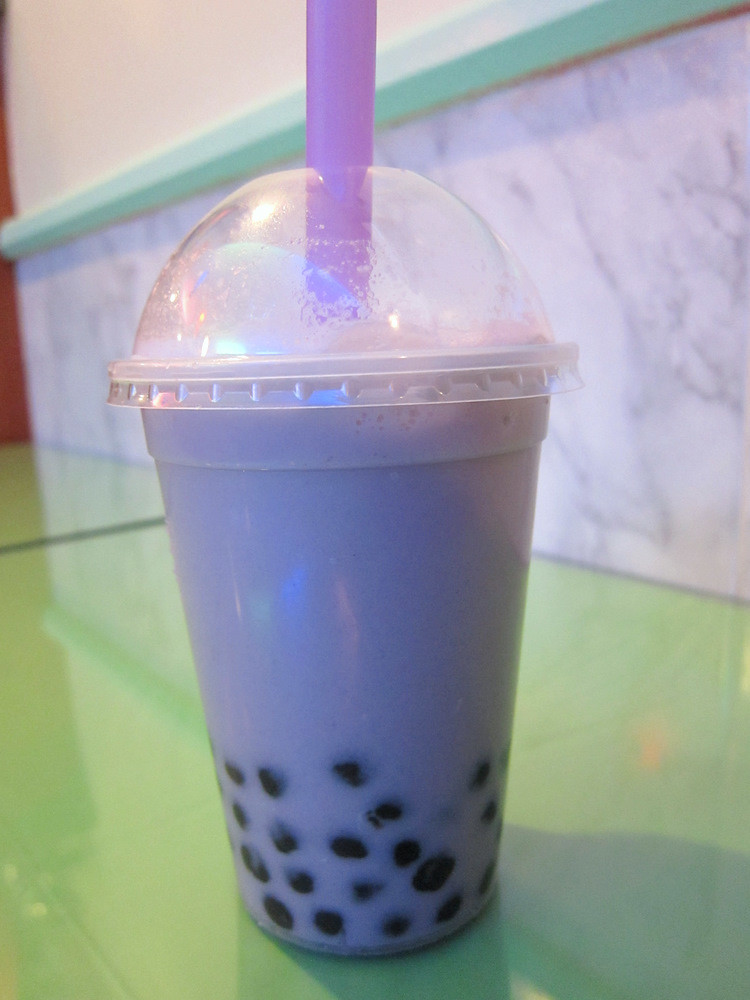What does taro milk tea taste like?
Taro milk tea has been gaining quite a bit of popularity lately, and for good reason. With its yummy taste and vibrant purple hues, it’s hard not to be intrigued.
Taro, the root vegetable responsible for the distinct flavor of this milk tea, has a mildly sweet and nutty taste that is often compared to a sweet potato or vanilla. The milk in the tea provides a creamy and smooth texture, and it is often sweetened with sugar or honey to balance out the earthiness of the taro. Some variations of taro milk tea may also include other flavors such as coconut, almond, or chocolate.
All ingredients balance to create a pleasant sensation in your taste buds. If all of this sounds fascinating, keep reading because I have much more to share about this luscious drink!
Please note: This article contains affiliate links, meaning I may earn a commission if you make a purchase by clicking a link. Of course, this comes at no extra cost to you and helps me to keep offering solid information to readers.

What Is Taro Milk Tea?
Taro milk tea, often recognized for its vibrant purple color, originated in Taiwan and has become popular worldwide. It is made by blending taro root with milk, sugar, and sometimes other ingredients such as cream or coconut milk.
Even though this milk tea can be considered a “modern” concoction, taro has been a staple ingredient in Asian cuisine for centuries.
It is often served cold with ice, and can also be made into a hot beverage.
Taro milk tea is typically served with small chewy tapioca balls, also known as boba or pearls, which add a fun and unique texture to the drink (that is why sometimes it is called taro boba tea or taro bubble tea). It can also be customized with different sweetness levels and toppings such as fruit or grass jelly.
Nowadays, taro milk tea can be found in various forms, such as smoothies, slushies, and even more creative preparations. As you explore different boba shops, you’re likely to come across different interpretations of taro milk tea, allowing you to further appreciate the versatility of this colorful drink.
What Does Taro Milk Tea Taste Like?
Sweet and Nutty Taste
When you sip taro milk tea, one of the first things you’ll notice is the sweetness. The mix of taro, sugar, and milk creates a delightful balance of flavors.
You’ll often detect a natural, earthy, and nutty flavor in taro milk tea that sets it apart from other types of milk teas. This nutty flavor, reminiscent of roasted nuts or even buttered popcorn, adds a sense of depth to the overall taste.
Moreover, taro milk tea can be mixed with additional flavors, such as vanilla or chocolate, further enhancing its taste. For instance:
- The vanilla complements the taro’s natural sweetness and adds a hint of smoothness.
- A chocolate variant brings out a richer taste, creating a delightful balance between the taro’s nuttiness and the sweetness of the chocolate.
Creamy and Smooth Texture
In addition to its enjoyable taste, taro milk tea is known for its creamy and smooth texture. This is achieved by the combination of:
- Milk: Adding milk to the tea gives it a rich, velvety texture. You can use different types of milk, like whole, skim, or non-dairy alternatives, to suit your preferences.
- Tapioca Pearls: Often, taro milk tea comes with soft, chewy tapioca pearls at the bottom of the cup. These pearls provide an interesting contrast to the smooth consistency of the tea.
To further customize your taro milk tea, consider the following options:
- Adjust the sweetness by adding more or less sugar, or use alternative sweeteners like honey or agave nectar.
- Change the thickness using different milk types or add whipped cream for an extra indulgent experience.

Ingredients and Variations
Main Components
To make taro milk tea, you’ll need the following main components:
- Black tea: This is the base of your milk tea. You can use loose-leaf tea or tea bags. Steep in hot water for 3-5 minutes.
- Taro or Taro Powder: This ingredient gives the milk tea a distinct flavor and color. If bought fresh, you will need to cook and prepare. The alternative is to use taro powder. You can find it at specialty shops or online.
- Milk: To achieve a creamy texture, you can use whole milk, 2% milk, or even non-dairy milk like almond or soy milk.
- Sugar: Adjust the sweetness to your preference. You can use regular sugar, brown sugar, or honey as a natural sweetener.
- Cooked tapioca balls: Follow package instructions to prepare them
Alternative Ingredients
For more variations of taro milk tea, you can use these alternative ingredients:
- Green tea: Replace black tea with green tea for a lighter and refreshing taste.
- Creamer: If you prefer a creamier consistency, use a non-dairy creamer instead of milk.
- Almond milk: This non-dairy milk option adds a slightly nutty flavor to your taro milk tea.
- Condensed milk: Add condensed milk instead of sugar for a richer and creamier texture.
- Soy milk: Another non-dairy milk option that blends well with taro flavor.
- Brown sugar syrup: Drizzle this syrup into your taro milk tea for a caramel-like sweetness.
Remember to personalize your taro milk tea by adjusting the ingredients and their amounts to your liking.
How to Make Taro Milk Tea at Home
We start by providing a recipe where taro paste is used.
Ingredients
For Taro Paste
- 1 cup peeled and diced taro root
- 1/4 cup granulated sugar (adjust to taste)
- 1/4 cup milk (any type, dairy or non-dairy)
- 1 tablespoon unsalted butter (optional, for creaminess)
- Water
For Taro Milk Tea
- 2-3 tablespoons taro paste
- 1 cup brewed black tea (cooled)
- 1/2 cup milk (any type)
- 1-2 tablespoons simple syrup (adjust to taste)
- Ice cubes
- Cooked tapioca pearls (optional)
Instructions
Making Taro Paste
- Start by peeling and dicing the taro root into small cubes.
- Place the diced taro in a pot and cover with water. Bring it to a boil and let it simmer for 15-20 minutes or until the taro is soft and easily pierced with a fork.
- Drain the taro cubes and let them cool slightly.
- In a blender or food processor, add the cooked taro, granulated sugar, milk, and butter (if using). Blend until you have a smooth paste-like consistency. You can adjust the sugar quantity based on your preference for sweetness.
- Transfer the taro paste to a container and let it cool completely. You can refrigerate it for later use as well.
Making Taro Milk Tea
- Brew a cup of black tea. Use 1-2 tablespoons of loose black tea leaves or 1 teabag for every 1 cup of water. Bring the water to a boil in a saucepan before adding the tea leaves. Allow the tea to steep for 3-5 minutes, then strain the leaves and let the tea cool down to room temperature. Adjust the strength of the tea according to your preference.
- Add 2-3 tablespoons of the prepared taro paste to a glass. You can adjust the amount based on how strong you want the taro flavor.
- Add the cooled black tea to the glass. If you want a stronger tea flavor, you can increase the amount of tea.
- Pour in the milk of your choice. You can use dairy milk or non-dairy alternatives like almond milk, coconut milk, etc.
- Add 1-2 tablespoons of simple syrup to sweeten the milk tea. Adjust the amount according to your desired level of sweetness.
- Add ice cubes to the glass to chill the taro milk tea.
- Stir well to combine all the ingredients and evenly distribute the taro paste.
- Taste the taro milk tea and adjust the sweetness or milkiness if needed.
- Optionally, you can top the taro milk tea with tapioca pearls, whipped cream, or a sprinkle of crushed taro chips for added texture and presentation.
- Serve the taro milk tea chilled and enjoy!
Now, here is the recipe using taro powder.
Ingredients
- 2 tablespoons taro powder
- 1/4 cup hot water
- 1 cup brewed black tea (cooled)
- 1/2 cup milk (any type)
- 1-2 tablespoons simple syrup (adjust to taste)
- Ice cubes
- Cooked tapioca pearls (optional)
Instructions
- In a glass, add 2 tablespoons of taro powder.
- Pour 1/4 cup of hot water into the glass with the taro powder. Stir well until the taro powder is fully dissolved and you have a smooth taro paste.
- Brew a cup of black tea and let it cool.
- Once the taro paste is well dissolved, add the cooled black tea to the glass.
- Pour in the milk of your choice. As with the previous recipe, you can use dairy milk or non-dairy alternatives like almond milk, coconut milk, etc.
- Add 1-2 tablespoons of simple syrup to sweeten the milk tea. Adjust the amount based on your desired level of sweetness.
- Add ice cubes to the glass to chill and dilute the tea.
- Stir well to combine all the ingredients and ensure the taro paste is evenly distributed.
- Taste the taro milk tea and adjust the sweetness or milkiness if necessary.
- Optionally, you can also top the taro milk tea with tapioca pearls, whipped cream, or a sprinkle of crushed taro chips.

Health Benefits and Nutrients
Vitamins and Minerals
When you sip on a taro milk tea, you are not just indulging in a delicious beverage; you’re also consuming various vitamins and minerals. Taro is a rich source of essential nutrients like:
- Vitamin C: Supports your immune system and has antioxidant properties.
- Vitamin B6: Aids in brain development and maintains your nervous system health.
- Calcium: Essential for strong bones and teeth, as well as muscle function.
- Phosphorus: Assists with energy production, kidney function, and bone health.
- Magnesium: Helps maintain a healthy heartbeat and regulates blood pressure.
- Potassium: Essential for proper muscle function, fluid balance, and maintaining a healthy blood pressure.
Dietary Fiber
Taro root is also an excellent source of dietary fiber, which offers numerous health benefits. Consuming enough fiber can:
- Promote a healthy digestive system by preventing constipation and supporting regular bowel movements.
- Help you feel fuller for longer, which could assist with weight management.
- Lower cholesterol levels by binding to cholesterol and removing it from your bloodstream.
- Manage blood sugar levels by slowing down the absorption of sugar from the gut into the bloodstream.
Antioxidants
Antioxidants play a crucial role in protecting your cells from damage caused by free radicals, which are linked to various chronic diseases and aging. Taro milk tea is full of antioxidants, such as vitamin C and other compounds that work together to keep your body functioning optimally by:
- Neutralizing harmful free radicals.
- Reducing inflammation and promoting a healthy immune response.
- Protecting your cardiovascular system by preventing oxidative stress.
Potential Drawbacks and Considerations
While taro milk tea can be a refreshing beverage, there are some considerations that should be kept in mind before consuming it.
- High in calories: The sweeteners in the drink can contribute to a high calorie count.
- High in sugar: Along with the high calorie count, taro milk tea can also be high in sugar. It’s important to be mindful of the amount of sugar in this drink and choose unsweetened options whenever possible.
- Potential for allergies: Taro is a root vegetable that is known to cause allergic reactions in some individuals. People with allergies to other root vegetables, such as potatoes, may also be allergic to taro. It’s important to be aware of any potential allergies and seek medical attention if symptoms arise.
- Use of additives: Some taro milk tea may contain additives such as artificial flavors, colors, and preservatives. These additives can have negative health effects, so it’s important to read ingredient labels and choose products that use natural ingredients.
As with any food or beverage, moderation, and informed decision-making are key to maintaining a healthy lifestyle.

“me & my egg roll taro bubble tea” by goodiesfirst is licensed under CC BY 2.0.
Taro Milk Tea Shopping List
We have provided the knowledge necessary to prepare this milk tea at home. Here are our recommendations for the main ingredients.
Black Tea
Organic Positively Tea Company, Yunnan Black Tea

Vahmad, Himalaya Gold Black Tea

Taro Powder
Qbubble Tea Powder Taro Powder


Tapioca Pearl (Boba or Bubbles)

Black Bubble Tea Boba Tapioca Pearl

Kits
Flavfar Taro Milk Tea with Tapioca Pearl

Boba Fide Taro Latte Boba Tea Kit

Taro Fun Facts
Let’s finish the article by presenting some interesting facts about taro.
- Taro is one of the oldest cultivated crops in the world, with evidence of its cultivation dating back over 6,000 years.
- Taro is a staple food in many cultures, particularly in Southeast Asia, the Pacific Islands, and Africa.
- Taro leaves can also be eaten and are often used in dishes such as soups and stews.
- Taro has a distinct starchy flavor and is often compared to potatoes or sweet potatoes.
- Taro is a versatile ingredient and can be boiled, mashed, fried, or roasted.
- Taro is often used in traditional medicine to treat various ailments such as headaches, arthritis, and digestive issues.
- In some cultures, taro is believed to have spiritual or symbolic significance and is used in religious ceremonies or rituals.
- Taro has been used to create eco-friendly products, such as biodegradable packaging, due to its high starch content.
- Taro is used as a base ingredient for a variety of foods and beverages, including taro chips, and taro ice cream.
- I grew up eating taro (in Puerto Rico). It is one of my favorite root vegetables. My mom used to prepare it in so many ways. She even made flan with it (which by the way, is delicious).
Well my friends, hope you have enjoyed the article and learned something new. Let me know what are your favorite taro drinks.
To you, what does taro milk tea taste like?
More About Milk Tea
What Does Milk Tea Taste Like?
What Does Thai Milk Tea Taste Like?
What Does Honeydew Milk Boba Taste Like?
Everything About Tiger Milk Tea
What Does Jasmine Milk Tea Taste Like?